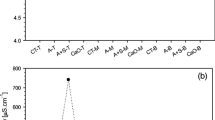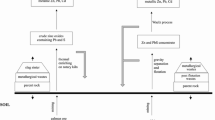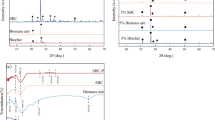Abstract
This study reported the test done on ash-sludge mixture foramendment of soil in pot experiments. Ash-sludge mixture ratiostudies revealed that 1:5 fly ash-sludge mixture and 1:10 bottom ash-sludge mixture were the optimum mixture ratio thatminimized toxic element and provided sufficient nutrients. Experiments indicated that ash-sludge mixtures is more suitablefor amendment of acid soil than neutral soil which can increasesoil pH and reduce available heavy metal toxicity. The maximumheavy metal adsorption occurred in a pH range of 4 to 6 for allsoil studied. The finding also revealed that fly ash applicationseemed more effective than bottom ash, due to its higher loadingrate and metal contents. Heavy metal toxicity was monitored usingseed germination test. Marigold and tomato seeds were the two crops selected for this test. Seed germination test result showsthat percentage of seed germination increased in pot experimentswith sludge only and ash-sludge mixtures. In addition, higherpercentages of seed germination were observed to vary with longer incubation time (1–8 weeks). After week 12 of the incubation period, percentage of seed germination began to decline, as a result of reduced soil pH and release of toxic heavy metals.
Similar content being viewed by others
References
Adriano, D. C.: 1992, Biogeochemistry of Trace Metals, Lewis Publisher, Baton Rouge, Fla., pp. 109–158.
Alloway, B. J.: 1995, Heavy Metals in Soils, Blachie Academic and Professional, Chapman and Hall, U.K.
Andersson, M.:1988, ‘Toxicity and tolerance of aluminum in vascular plants’, Water, Air, Soil Pollut. 39, 439–462.
Bohn, H., McNeal, B. and O'Conner, G.: 1979, Soil Chemistry, Wiley Interscience, NY.
Bouton, J. H. and Sumner, M. E.: 1983, Plant Soil 74,431.
Carter, R. Martin: 1993, Soil Sampling and Methods of Analysis, Canadian Society of Soil Science, Lewis publishers, U.S.A.
Curtin, D. and Smillie, G. W.: 1986, Plant Soil 95, 23.
Department of Land Development: 1972, DetailedReconnaissance Soil Map of Southern Central Plain Area, Soil Survey Division, Department of Land Development, Ministry of Agriculture and Cooperatives, Thailand.
Dowdy, R. H., Solan, J. J., Dolan, M. S. and Linden, D. R.: 1997, ‘Long-term effects of biosolids applicationson heavy metal bioavailability in agricultural soils’, J. Environ. Qual. 26, 966–974.
Foy, C. D.: 1982, Manuscript for Handbookof Nutrition and Food, CRC Press, Boca Raton, Florida.
Hansen, L. G. and Chaney, R. L.: 1984, ‘Environmental and food chaineffects of the agricultural use of sewage sludges’, Rev. Environ. Toxicol. 1, 103.
Hendershot, W. H., Lalande, H. and Duquette, M.:1993, Soil pH: Soil Sampling and Method of Analysis, Lewis Publishing, U.S.A.
McBride, M. B.: 1995, ‘Toxic metalaccumulation from agricultural use of sludge: Are USEPA regulations protective’, J. Environ. Qual. 24, 5–18.
McGill, W. B. and Fiqueiredo, C. T.: 1993, Total Nitrogen: Soil Sampling and Method of Analysis, Lewis Publishers, U.S.A.
Mengel, K. and Kirkby, E.A.: 1982, Principles of Plant Nutrition. Switzerland, International Potash Institute.
O'Halloran, I. P.: 1993, Phosphorus: SoilSampling and Method of Analysis, Lewis Publishers, U.S.A.
Page, A. L., Bingham, F. T. and Chang, A. C.: 1981, in N.W. Lepp (ed.), Effect of Heavy Metal Pollution on Plants, Vol. 1, Applied Science, London, pp. 72–109.
Pahlsson, A. M. B.:1989, ‘Toxicity of heavy metals (Zn, Cu, Cd, Pb) to vascular plants’, Water, Air, Soil Pollut. 47, 287–319.
Porter, J. R. and Sheridan, R. P.: 1981, Plant Physoil. 68, 143.
Rhoades, J. D.: 1982, Soil Cation Exchange Capacity: Soil Sampling andMethod of Analysis, Lewis Publishers, U.S.A.
Rayan, J. A., Pahren, H. R. and Lucas, J. B.: 1982, ‘Controlling cadmium in thehuman food chain: A review and rationale based on health effects’, Environ. Res. 28, 251.
Scherbatskoy, T., Klern, R. M. and Badger, G. J.: 1987, Environ. Exp. Bot. 27, 157.
Schwab, A. R., Tomecek, M. B. and Ohlendbusch, P. D.: 1991, ‘Plantavailability of lead, cadmium and boron in amended coal ash’, Water, Air, Soil Pollut. 57–58, 297–306.
Soon, Y. K. and Abboud, S.:1993, Total Heavy Metals: Soil Sampling and Method of Analysis, Lewis Publishers, U.S.
Ulrich, B.: 1983, in:A. Cammerer (ed.), Pollution Stresses on Forest Ecosystems, Environment Canada.
Ure, A. M. and Berrow, M. L.: 1982, in H.J. M. Boiwen (ed.), Environmental Chemistry, Roy. Soc. Chem., London.
US EPA: 1989, Environmental Regulations andTechnology: Control of Pathogens in Municipal Wastewater Sludge for Land Application under 40 CFR part 257, EPA Pub. No. EPA-625/1089/006. Cincinnati, Ohio, U.S.A.
Vlek, L. G.: 1985, ‘Micronutrients in tropical food crop production’, Develop. Plant Soil Sci. 14, 38–149.
Xian et al.: 1989, ‘Effect of pH on chemical forms and plant availability of cadmium, zinc and lead in polluted soils’, Water, Air,Soil Pollut. 45, 265–273.
Author information
Authors and Affiliations
Corresponding author
Rights and permissions
About this article
Cite this article
Parkpian, P., Leong, S.T., Laortanakul, P. et al. An Environmentally Sound Method for Disposal of Both Ash and Sludge Wastes by Mixing with Soil: A Case Study of Bangkok Plain. Environ Monit Assess 74, 27–43 (2002). https://doi.org/10.1023/A:1013850620819
Issue Date:
DOI: https://doi.org/10.1023/A:1013850620819




